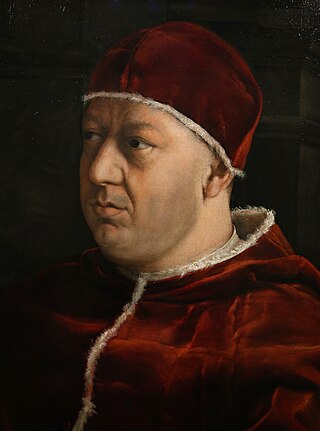
Pisa is a city and comune in Tuscany, central Italy, straddling the Arno just before it empties into the Ligurian Sea. It is the capital city of the Province of Pisa. Although Pisa is known worldwide for its leaning tower, the city contains more than twenty other historic churches, several medieval palaces, and bridges across the Arno. Much of the city's architecture was financed from its history as one of the Italian maritime republics.

Pope Leo X was head of the Catholic Church and ruler of the Papal States from 9 March 1513 to his death, in December 1521.

Cesare Baronio, C.O. was an Italian Oratorian, cardinal and historian of the Catholic Church. His best-known works are his Annales Ecclesiastici, which appeared in 12 folio volumes (1588–1607). He is under consideration for sainthood and, in 1845, Pope Benedict XIV declared him Venerable.

Gaetano dei Conti di Thiene, known as Saint Cajetan, was an Italian Catholic priest and religious reformer, co-founder of the Theatines. He is recognised as a saint in the Catholic Church, and his feast day is 7 August.

The War of the League of Cambrai, sometimes known as the War of the Holy League and several other names, was fought from February 1508 to December 1516 as part of the Italian Wars of 1494–1559. The main participants of the war, who fought for its entire duration, were France, the Papal States, and the Republic of Venice; they were joined at various times by nearly every significant power in Western Europe, including Spain, the Holy Roman Empire, England, the Duchy of Milan, the Republic of Florence, the Duchy of Ferrara, and the Swiss.

The Archdiocese of Genoa is a Latin Church ecclesiastical territory or diocese of the Catholic Church in Italy. Erected in the 3rd century, it was elevated to an archdiocese on 20 March 1133. The archdiocese of Genoa was, in 1986, united with the Diocese of Bobbio-San Colombano, forming the Archdiocese of Genoa-Bobbio; however a split in 1989 renamed it the "Archdiocese of Genoa."

The Theatines, officially named the Congregation of Clerics Regular, is a Catholic order of clerics regular of pontifical right for men founded by Archbishop Gian Pietro Carafa on 14 September 1524.

The Diocese of Vicenza is a Latin diocese of the Catholic Church in Italy. It is located in the region of the Veneto, and is the capital of the Province of Vicenza, approximately 60 km west of Venice, and around 45 km east of Verona. The diocese was in existence before 590. Vicenza was a suffragan of the Patriarchate of Aquileia until 1751. In 1751 it was transferred to the ecclesiastical province of Udine. In 1818, upon the dissolution of the ecclesiastical province of Udine, Vicenza was made it a suffragan of the Patriarchate of Venice.

Niccolò Ridolfi was an Italian cardinal.
Luigi Lippomano was an Italian bishop and hagiographer.

The history of Corsica in the medieval period begins with the collapse of the Western Roman Empire and the invasions of various Germanic peoples in the fifth century AD, and ends with the complete subjection of the island to the authority of the Bank of San Giorgio in 1511.

Gian Matteo Giberti was an Italian diplomat, Bishop of Verona.
San Bernardo della Compagnia was a small church in Rome, next to Trajan's Column, dedicated to Saint Bernard and the Virgin Mary.

The Diocese of Savona-Noli is a Latin diocese of the Catholic Church in northern Italy. It was historically the Diocese of Savona, from the tenth century. In 1820 the Diocese of Noli was united to the Diocese of Savona. It is a suffragan of the Archdiocese of Genoa.

The Delle Piane family is an old Genoese noble family first recorded in Polcevera in 1121. Over the past ten centuries it has produced many distinguished government officials, clerics, diplomats, soldiers and patrons.

Francesco Panigarola was an Italian Franciscan preacher and controversialist, and Bishop of Asti.
Delegation for the Assistance of Jewish Emigrants or DELASEM, was an Italian and Jewish resistance organization that worked in Italy between 1939 and 1947. It is estimated that during World War II, DELASEM was able to distribute more than $1,200,000 in aid, of which nearly $900,000 came from outside Italy.
Uberto Gambara (1489–1549) was an Italian Roman Catholic bishop and cardinal.

Giovanni Rucellai, known as Giovanni di Bernardo Rucellai, was an Italian humanist, poet, dramatist and man of letters in Renaissance Florence, in Tuscany, Italy. A member of a wealthy family of wool merchants and one of the richest men in Florence, he was cousin to Pope Leo X and linked by marriage to the powerful Strozzi and de' Medici families. He was born in Florence, and died in Rome. He was the son of Bernardo Rucellai (1448–1514) and his wife Nannina de' Medici (1448–1493), and the grandson of Giovanni di Paolo Rucellai (1403–1481). He is now remembered mostly for his poem Le Api, one of the first poems composed in versi sciolti to achieve widespread acclaim.
The Diocese of Mariana in Corsica was a Roman Catholic ecclesiastical territory in Mariana, Corsica, in the north-eastern corner of the island. In 1563 the diocese was united with the Diocese of Acci(a) to form the Diocese of Accia and Mariana. Both dioceses were poor and had lost population. Mariana had been abandoned and its bishop lived in Bastia to the north, the seat of the civil government of the island. The Cathedral sat alone near the banks of the River Golo some three miles from the sea, in the midst of fields.